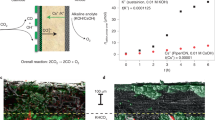Abstract
Intensification of the electrochemical production of chlorine and sodium hydroxide (i.e., the chlor-alkali process) was demonstrated in a centrifugal acceleration field. This intensification was shown by comparing the cell voltages and the anode potentials for a cell operated with and without a centrifugal field applied using the linear sweep voltammetric, galvanostatic and potentiostatic polarizations. Under industrial chlor-alkali electrolysis conditions, a cell voltage reduction of up to 600 mV and an anode potential reduction of up to 360 mV at 600 mA cm−2 were achieved by using a relative acceleration rate of 190 g with an acidic saturated NaCl solution at 80 °C. The relationships between the cell performance and relative acceleration rate, for different anode materials, temperature and NaCl concentration are reported.
Similar content being viewed by others
References
Published annually in J. Electrochem. Soc.
D. Pletcher and F.C. Walsh, ‘Industrial Electrochemistry’ (Chapman & Hall, London, 3rd Edition, 1993), Chapter 3.
K. Kinoshita, ‘Electrochemical Oxygen Technology’ (John Wiley & Sons, New York, 1992), pp. 339–348.
D.L. Caldwell, Production of Chlorine, in J.O'M. Bockris, B.E. Conway, E. Yeager and R.E. White (Eds), ‘Comprehensive Treatise on Electrochemistry', Vol. 2 (Plenum, New York, 1981), pp. 105–166.
M.O. Coulter (Ed.), ‘Modern Chlor-Alkali Technology', Vol. 1 (Ellis Horwood, Chichester, 1980).
C. Jackson (Ed.), ‘Modern Chlor-Alkali Technology', Vol. 2 (Ellis Horwood, Chichester, 1983).
K. Wall (Ed.), ‘Modern Chlor-Alkali Technology', Vol. 3 (Ellis Horwood, Chichester, 1986).
N.M. Prout and J.S. Moorhouse (Eds.), ‘Modern Chlor-Alkali Technology ‘, Vol. 4 (Elsevier, London, 1990).
T. Wellington (Ed.), ‘Modern Chlor-Alkali Technology', Vol. 5 (Elsevier, London, 1990).
R. Corry (Ed.), ‘Modern Chlor-Alkali Technology', Vol. 6 (Wiley, Chichester, 1995).
S. Trasatti and W.E. O'Grady, in H. Gerischer and C.W. Tobias (Eds), ‘Advances in Electrochemistry & Electrochemical Engineering', Vol. 12 (J. Wiley & Sons, New York, 1981), pp. 177–261.
R.D. Varjian, AIChE Symp. Ser. 204 77 (1981) 219.
M.M. Silver, AIChE Symp. Ser. 204, 77 (1981) 234.
D.S. Cameron, R.L. Phillips and P.M. Willis, in N.M. Prout and J.S. Moorhouse (Eds), ‘Modern Chlor-Alkali Technology', Vol. 4 (Elsevier, London, 1990), pp. 95–107.
O. de Nora, Chem.-Ing.-Techn. 42 (1970) 222.
C. Ramshaw, Heat Recovery Syst. CHP 13 (1993) 493.
D.R. Gabe and F.C. Walsh, I. Chem. E. Symp. Ser. 116 (1990)219.
H. Cheng, ‘Intensi.ed Electrochemical Processes', PhD thesis, University of Newcastle upon Tyne, Newcastle upon Tyne, UK (1999).
M. Shen and Y. Chen, in N.M. Prout and J.S. Moorhouse (Eds), ‘Modern Chlor-Alkali Technology', Vol. 4 (Elsevier, London, 1990), pp. 149–157.
D. Galizzioli, F. Tantardini and S. Trasatti, J. Appl. Electrochem. 4 (1974) 57.
Y. Katoh, Y. Nishiki and S. Nakamatsu, J. Appl. Electrochem. 24 (1994) 489.
L.D. Burke and J.F. Healy, J. Electroanal. Chem. 101 (1979) 341.
H. Vogt, Electrochim. Acta 29 (1984) 167.
H. Vogt, Electrochim. Acta 29 (1984) 175.
L. Muller, M. Krenz and R. Landsberg, J. Electroanal. Chem. 180 (1984) 453.
L.J.J. Janssen and J.G. Hoogland, Electrochim. Acta 15 (1970) 1013.
H. Vogt, in E. Yeager, J.O'M. Bockris, B.E. Conway and S. Sarangapani (Eds), ‘Comprehensive Treatise on Electrochemistry', Vol. 6 (Plenum, New York, 1983), pp. 445–489.
J.H. Austin, in K. Wall (Ed.), ‘Modern Chlor-Alkali Technology', Vol. 3 (Ellis Horwood, Chichester, 1986), pp. 131–146.
F. Hine, M. Yasuda, T. Noda, T. Yoshida and J. Okuda, J. Electrochem. Soc. 126 (1979) 1439.
E.A. Kalonovskii, R.U. Bondar and N.N. Meshkova, Elektrokhimiya 8 (1972) 1468.
A.T. Kuhn and C.J. Mortimer, J. Appl. Electrochem. 2 (1972) 283.
H. Cheng, K. Scott and C. Ramshaw, submitted to Chem. Eng. Sci.
A.J. Bard and L.R. Faulkner, ‘Electrochemical Methods’ (J. Wiley & Sons, New York, 1980), p. 571.
Author information
Authors and Affiliations
Rights and permissions
About this article
Cite this article
Cheng, H., Scott, K. & Ramshaw, C. Chlorine evolution in a centrifugal field. Journal of Applied Electrochemistry 32, 831–838 (2002). https://doi.org/10.1023/A:1020170627227
Issue Date:
DOI: https://doi.org/10.1023/A:1020170627227




